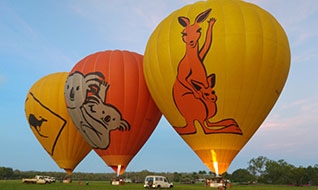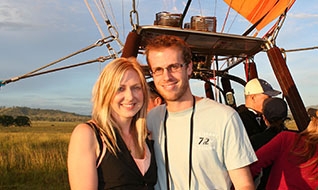The First Hot Air Balloon
Rising From the Embers: A Look at the First Hot Air Balloon
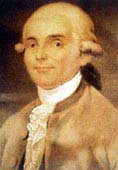
Inspiration for the first hot air balloon reputedly came while gazing into a fire contemplating military assaults. Joseph Montgolfier was watching clothing drying over flames. As the heat and sparks from the fire rose, pockets on the clothing were billowing open, causing the pockets to rise up. The French had been unable to assault Gibraltar, a fortress they couldn’t reach by land or sea. It occurred to Joseph that if French troops could somehow be transported in something that lifted them, such as the pockets were being lifted, they would have their chance at successfully penetrating Gibraltar.
Montgolfier Gas
Not knowing what it was that made the pockets react as they did, Joseph believed the fire created a special type of gas. He would later call this Montgolfier Gas, a gas he thought caused levity. With this information, he began to create the first model of his hot air balloon.
First Concepts
Joseph began with some lightweight wood and constructed a small box. He covered the box and top of it with taffeta, a lightweight woven material made from silk. To figure out if it would lift off the ground, he burnt paper underneath the bottom of the box. It quickly began to lift until it hit the ceiling. Knowing he was onto something, Joseph recruited his brother Etienne to help him, and the process of designing a balloon that would carry people was off the ground.
From Concept to Experiments
The next experiment would see the Montgolfier brothers build a much larger box with more taffeta and cord. The balloon quickly took off with a great force and the brothers were unable to control it. The balloon ended up floating almost two kilometers away, and was ruined on impact.
Third Attempt Successful
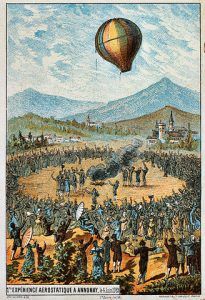
The third attempt was designed with a rounder shape and the brothers used sackcloth instead of taffeta. Sackcloth is stronger and thicker, but the brothers also added alum inside the sackcloth to help prevent fire. The alum was made by a man named Reveillon, a manufacturer of wallpaper. Wanting to establish themselves as the first inventors of flight, the Montgolfier brothers invited dignitaries from surrounding states to witness the flight of their balloon on 4 June 1783. Another test was performed on 11 September 1783, and news of the success spread quickly.
A Duck, a Rooster and a Sheep
The Montgolfier brother’s successful balloon would be exhibited in front of King Louis XVI, Marie Antoinette, and a crowd of thousands a mere eight days later. The balloon was properly decorated to be in front of royalty, with a blue background and gold designs. The difference was that this time, there were three passengers aboard: a duck, a rooster, and a sheep. The brothers wanted to see how animals did in flight before they sent a human up.
King Louis XVI reportedly didn’t care for the thick smoke, although Joseph felt it was the smoke that caused the balloon to lift off the ground. With the previous successful flights, the brothers began to work on a larger balloon that would be able to hold up the weight of a human.
First Human to Fly
About a month later, estimated on the 15th October, 1783, Étienne Montgolfier became the first human to fly in a hot air balloon which was connected to earth with a tether. Likewise that same day, Pilâtre de Rozier also enjoyed the exhilaration of tethered flight.
Free Flight
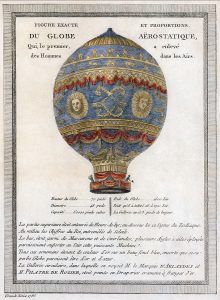
1783 balloonj" by Unknown - This image is available from the United States Library of Congress's Prints and Photographs division under the digital ID ppmsca.02447.This tag does not indicate the copyright status of the attached work. A normal copyright tag is still required. See Commons:Licensing for more information.. Licensed under Public Domain via Commons
On November 21, 1783, just over a month later, Pilâtre de Rozier and an officer from the army named the marquis d’Arlandes became the first human to experience free flight in a hot air balloon, and successfully flew without a tether above Paris for a distance of approximately 9 kiometres.
From Open Fire to Gas For buoyancy
Although the Montgolfier brothers and Pilâtre were successful with their designs for the first hot air balloon, just one month later, the first gas balloon lifted off in Paris, France. Nicholas Louis Robert and Jacques Alexander Charles would launch the first man in a hydrogen gas filled balloon. In two and a half hours, it flew over 40 km.
The Beginning of The Age of Flight
While modern day balloons use gas and not burning embers such as the Montgolfier brothers used, museums and flight historians around the world credit them as the world’s first hot air balloon inventors.
Similarly, the pioneering manned ascension by Francis Pilatre de Rosier and marquis d' Arlandes in Paris on November 21. 1783 provided the spark which ignited man's revolutionary age of flight.




